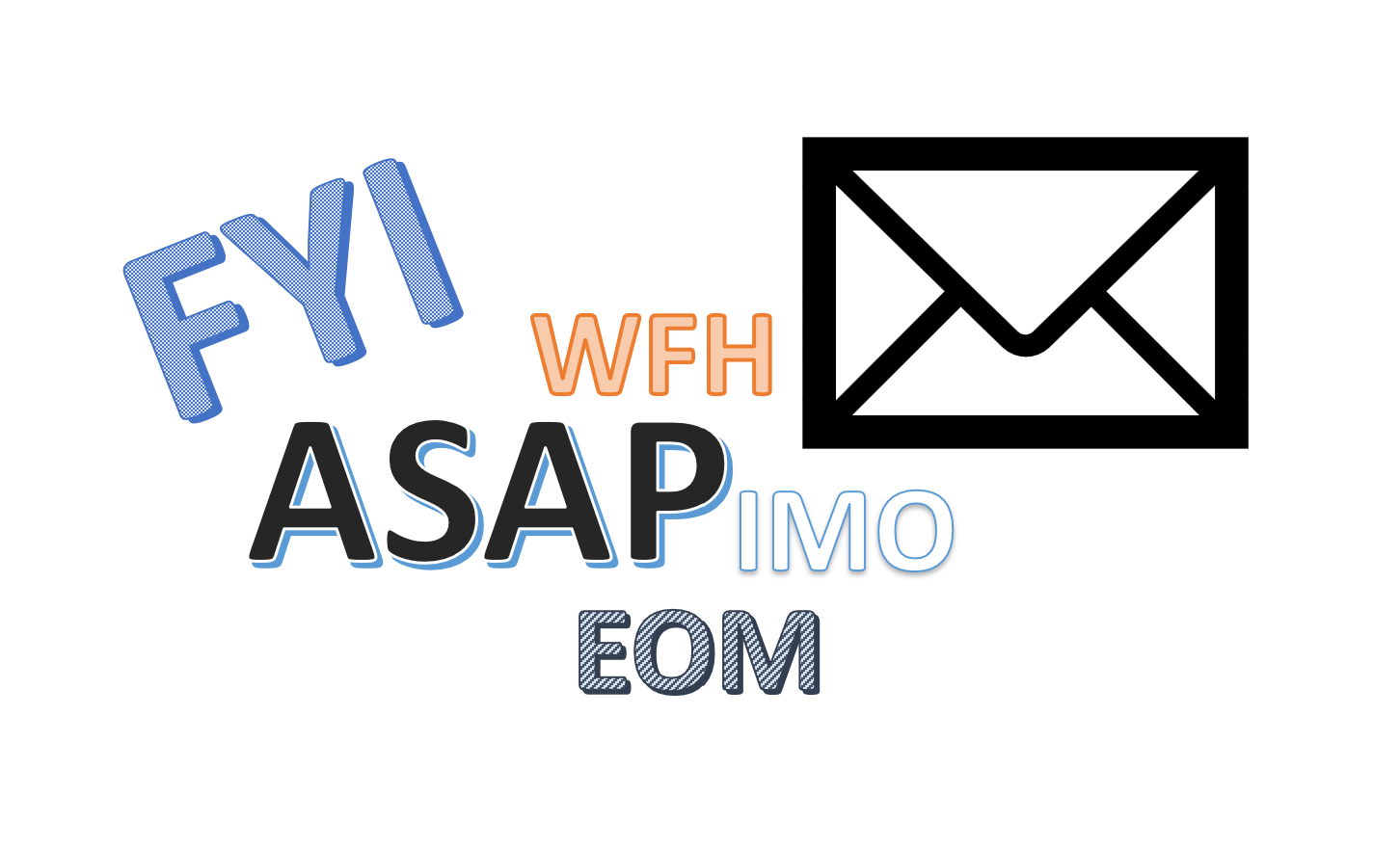General Email Acronyms, Description & How To Use Them
Communication has evolved to reflect the rush of daily lives. People are in a rush to communicate, write and read and as such, instant communication and busy schedules, abbreviations in emails have become the norm.
While these email acronyms help us save time, shorten messages and communicate better, they can be a cause of confusion for those who are unfamiliar to such jargons and have the opposite of the intended effect. It is also important not to use such acronyms in formal communication with clients or formal communication outside your organization.
FYI, FWIW, ASAP, EOD, TYT, EOD and many other such abbreviations are commonly seen on emails but we want to make sure you know what they mean and how to use them. Let’s see how good you are. We will start with the easy and most common and work our way to the least used and uncommon.
- ASAP – As Soon As Possible
A commonly used email acronym that highlight urgency. You can use this when you want the recipient to know the urgency of your request or action.
- Example: I’ll need to let our boss about the status of the contract by 5:00 pm today, so please send the draft to me ASAP.
- FYI – For Your Information
- Use this email acronym to offer helpful or necessary information to the person you’re contacting.
- Example: Here’s the latest version, FYI.
- BTW – By The Way
This email acronym is most commonly used to add information you forgot to include in a previous message or to stress an action or piece of information’s importance.
- Example: Don’t forget to include the latest email exchange with our agency so I can forward to our marketing team, BTW.
- Y/N – Yes or No?
- This is an easy one. If you want a quick, definitive answer to a question, use this abbreviation.
- Example: Will Monday 4 pm work – Y/N?.
- LMK – Let Me Know
An informal abbreviation that is often used at the end of a message to solicit feedback.
- Example: LMK if you have any questions.
- IMO – In My Opinion
- This email acronym is useful for sharing your personal opinion and not necessarily the opinion of others. You may also use IMHO (in my honest opinion / in my humble opinion) when you want to be really frank without showing arrogance.
- Example: We need to get better at managing the weekly meeting agenda, IMO.
- HTH – Hope That Helps
Similar to #2 FYI, this can be used when you’re offering useful or helpful information or context alongside your message.
- Example: I’ve attached the first draft for your review – HTH.
- TYT – Take Your Time
A good email acronym for letting the person you’re communicating with there is no rush in replying or taking action.
- Example: It would be great if you could finalize the sample report, feel free to TYT – there’s no strict deadline.
- IDK – I Don’t Know
A quick way of letting the recipient know that you can’t help or don’t have the answers they are looking for
- Example: IDK if they’ll be in the office at that time, but feel free to give them a call.
- OT – Off Topic
A quick way of segueing the conversation or jumping to a completely new topic.
- Thanks for the prompt follow up. OT – did you attend the conf. call this morning?
- TED – Tell, Explain, Describe
This one is handy if you want more details on an action or work brief, inviting the recipient to respond with further detail in their next email.
- Example: Can you TED exactly what the brief was about so we’re on the same page?
- TL;DR – Too Long; Didn’t Read
A common email acronym across social media, this acronym typically proceeds a short summary of everything mentioned at the end of a particularly lengthy email.
- Example: TL;DR the quarterly briefing has been postponed, but we’re still expected to share our updates by end of week.
- CC/BCC – Carbon Copy/Blind Carbon Copy
These email acronyms refer to the way an email is sent; either to Carbon Copy to a group of recipients, in which case everyone can see the full group, or Blind Carbon Copy specific recipients who will not be visible to the wider group.
- Example: Please CC me on this so I can follow up in your absence.
- ETA – Estimated Time of Arrival
Another email acronym that’s commonly spoken as well as written, this can be used to ask someone about the delivery date.
- Example: What’s the ETA on delivering our HR policy?
- YTD – Year-to-Date
Use this email acronym to mark a period of time since the beginning of the current year.
- Example: All teams must submit their slides for the quarterly update, including a slide on their YTD target progress.
- OOO – Out of Office
The 3 O’s is an acronym refers to the feature in an email program that automates responses to inform people communicating with you that you’re away from your emails, be it for personal or professional reasons. It can also be used to refer to someone who is away from the office. Make sure to keep your OOO up to date.
- Example: While Andy is OOO, I’ll be picking this up until his return.
- EOM – End of Message
EOM is typically included in email subject lines, indicating that there is no additional information in the email body and therefore the recipient doesn’t have to worry about opening the email up.
- Example: Reminder: Join us in the conference room for birthday cake at 1pm, EOM.
- WFH – Working From Home
With more of us working remotely than ever before, this email acronym has become very common. Use it to let people know that you won’t be in the office as usual.
- Example: I’m WFH today, but can dial via conference call.
- EOD – End of Day
This email acronym is typically used to set a deadline for the end of the working day.
- Example; Please ask Mohamed to have an update on the proposal by EOD.
- EOW – End of Week
Similar to #19 (EOD). This is usually used to set a deadline or sign-off point for the end of the current working week.
- Example: Everyone is required to send their time schedule in by EOW.




